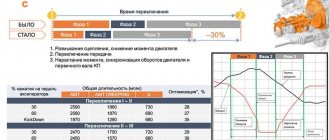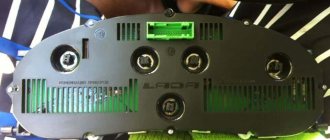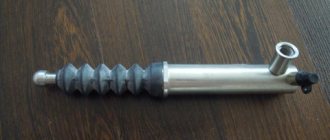05/27/2021 28,423 VAZ 2110
Author: Ivan Baranov
The VAZ 2110 is equipped with a five-speed gearbox. The article examines the design of the VAZ 2110 gearbox, provides examples of common problems and how to fix them. The principle of operation of a mechanical box can be visually assessed by watching the posted video.
[Hide]
1.71.2 driving a car with a manual transmission
If you press the accelerator pedal sharply or quickly downshift, the wheels may slip or slip and you may lose control of the vehicle.
SHIFTING GEARS ON A 5-SPEED TRANSMISSION • When shifting gears, fully depress the clutch pedal and move the gear lever to the desired position, and then smoothly release the clutch pedal.
• For smooth gear shifting, it is important to fully depress the clutch. If the clutch pedal is not fully pressed, then shifting into gear may be accompanied by extraneous noise (grinding of synchronizer teeth). This can cause serious damage to the transmission. • Start driving in 1st gear, then shift sequentially to 2nd, 3rd, 4th and 5th gears depending on your speed.
• To reverse, stop the vehicle completely, place the gear lever in neutral position N and then in position R.
Zigaben › Blog › Economical driving on VAZ 21124
Shift gears (if the speed drops to 1800) down one. Shifting through gears is more efficient, but kills the gearbox synchronizers very quickly. Driving in gear: neutral or pressing the clutch pedal again starts the fuel supply to the cylinders. ——— Driving at low speeds (up to 1600) is unprofitable for the following reasons: 1) Pulse supply continues fuel into the cylinders even when the gas pedal is released. 2) The engine is starving of oil.
In 1-2 gears this is not so critical; there periodic low speeds are forced.
We recommend reading: Deprivation of a debtor’s driver’s license in 2021
But in high gears it is very undesirable. We pick up the maximum possible / permissible speed as quickly as possible (but not more than 110) and go in the rpm range of 2000-3000 (higher makes sense unless
VAZ 2101 gearbox diagram
Contents: The transmission of the VAZ-2101 car consists of a manual gearbox, which transmits torque to the rear axle through a driveshaft. The gearbox itself is mechanical, 4-speed (4 forward gears and 1 reverse), three-way, with manual control (gear shifting is performed by the driver using a lever located in the car's interior). At the time of the release of the VAZ-2101, this type of gearbox was one of the highest priorities, since it ensured the least losses. To ensure that the car moved at different speeds, each of the gears had its own gear ratios, which decreased as the gearbox stage increased. So, the first gear has a gear ratio of 3.753, the second – 2.303, the third – 1.493, the fourth – 1.0. The rear gear has the highest gear ratio - 3.867. The changing gear ratios of the VAZ-2101 gearbox allowed the car to move at different speeds; in 1st gear a high traction force is provided, and in 4th gear the maximum possible speed is provided.
To reduce operating noise, all gears involved in forward movement have oblique teeth, while the gears of the rear stage have straight teeth.
To make it easy to control the gearbox and change gears with minimal impact, the forward gears are equipped with synchronizers. The cross-sectional diagram of the VAZ-2101 gearbox is presented below (PV - primary shaft, BB - secondary, PrV - intermediate, ZX - reverse):
1 – gearbox pan;2 – plug for the hole for controlling the amount of gearbox lubricant;3 – gear of the 2nd stage PrV;4 – gear of the 3rd stage of PrV;5 – PrV with a set of gears;6 – bearing PrV (front);7 – thrust bolt;8 – washer;9 – PRV gear (with constant clutch);10 – PV 4th stage synchronizer washer;11 – input shaft;12 – crankcase front cover;13 – oil seal;14 – PR bearing (rear); 15 – clutch housing; 16 – housing 17 – breather of the crankcase ventilation system; 18 – PV gear (with constant clutch); 19 – BB bearing (front); 20 – 4th stage synchronizer ring; 21 – 3rd and 3rd stage synchronizer clutch 4th stage;22 – 3rd stage synchronizer ring;23 – 3rd stage synchronizer spring;24 – 3rd stage explosive gear;25 – 2nd explosive stage gear;26 – 1st and 1st stage synchronizer clutch hub 2nd stage;27 – secondary shaft;28 – gear of the 1st stage of the explosive; 29 – bushing;30 – bearing BB (intermediate);31 – gear 3H BB;32 – lever rod;33 – cushion;34 – bushing;35,36 – bushings (remote, locking);37 – boot (external); 38 – boot (internal); 39 – lever support washer (spherical); 40 – gearbox lever; 41 – explosive oil seal (rear); 42 – cardan coupling flange; 43 – explosive nut; 44 – seal; 45 – ring; 46 – BB bearing (rear);47 – odometer gear;48 – odometer drive;49 – gearbox housing cover (rear);50 – 3X fork;51 – 3X gear (intermediate);52 – 3X PrV gear;53 – intermediate axis gears ЗХ;54 – gear of the 1st stage PrV;55 – magnet;56 – plug 1 – gearbox pan;
Design features
The VAZ-2101 gearbox diagram shows that the entire assembly consists of three shafts, which are placed in the gearbox housing. Despite the large number of components, the gearbox is relatively compact. Note that this diagram is not complete, since the sliders, latches and shift forks are not visible on it. They are located in the crankcase on the other side of the gearbox. The primary shaft receives torque from the crankshaft. To ensure the possibility of disconnecting the gearbox from the power plant, this connection is not made directly, but through the clutch mechanism. To ensure connection with the driven disk of the clutch mechanism on the first. The shaft has splines. The input shaft is secured to 2 bearings. Moreover, one of them (the front one) is located in the crankshaft, and the gearbox shaft is inserted into it with its end switch. The other is located in the front of the crankcase.
At the second end of the first. The shaft has a gear, and the shaft itself is made integral with it. This gear has a constant clutch with the industrial gear. shaft To prevent oil leakage, the rear bearing of this shaft is covered with an oil seal.
Front end sec. shaft enters the primary. To eliminate axial displacement and maintain their alignment relative to each other, the secondary shaft is mounted on 3 bearings. The front one is of a needle type, installed in the hole in the front end. shaft, where the second limit switch enters. shaft. The second bearing is intermediate, it is a ball bearing and it is installed behind the 1st stage gear. The third is also a ball-shaped one, located on the back of the second. shaft in the crankcase cover. Below these shafts there is another one - an intermediate one. At the same level with it there is a mechanism that ensures the car moves backwards.
A little about the principle of operation
The input shaft gear, as well as four industrial gears. shafts are made integral with the shafts. And only on the secondary shaft can the gears move along the shaft. This ensures the possibility of engaging the necessary gears. In “neutral” the torque is transmitted from the primary gear. shaft to the intermediate one through gears having constant mesh. But on the second. the shaft does not undergo this rotation, since in this position the engagement between the gears is industrial. and sec. there are no shafts. The driver, including first gear, using a shift fork mounted on the slider, moves the 1st stage gear of the second through the synchronizer. shaft and engages it with the gear on the industrial. shaft. All other stages are switched on in approximately the same way. To prevent the inclusion of two stages at the same time, the driver, before turning on the required speed, first disengages the gears of the engaged stage, that is, first moves the lever to “neutral”, and then connects the necessary gears. In order for the gears engaged in the second. shafts have not returned to their original position due to axial force, clamps are used - special spring-loaded balls, which, once in the recesses on the slide, do not allow it to move back. In order to ensure rotation of the second. shaft in the opposite direction (reverse movement), the design of the gearbox includes an additional intermediate axle with a gear, which is connected to the gears of the intermediate and secondary shafts using a separate fork.
In general, the entire operation of the VAZ-2101 gearbox is based on the interaction of gears of different diameters, assembled in one housing and mounted on shafts, which allows you to change the gear ratio in the desired direction.
Article on the topic - Removing the gearbox
Video - installation and repair of a VAZ gearbox
Self-adjustment of the scenes on the VAZ 2110
- Loosen the clamp.
- Engage reverse and position the lever as you would like it to be in that position.
- Then tighten the clamp and check how the rocker works, whether you are satisfied with the current position of the lever and the operation of the rocker.
- Turn on first speed.
- Loosen the rocker clamp.
- Turn the rocker drive counterclockwise until the gearshift lever begins to rest against the plastic reverse speed stop.
- Tighten the clamp and check how everything works.
We recommend reading: Can a Labor Veteran Use Free Travel in Moscow?
Gear shift
If you forget or ignore this requirement, then your car’s transmission repair is guaranteed. It is worth noting that the technique for shifting different gears lower or higher differs from each other. The common thing is that you need to depress the clutch, engage the gear and release the clutch, and you need to do this quickly if the car is already moving. She won't stall. But slowly releasing the clutch while driving threatens to break its disc, which will cost you a lot. So, you are new to the wheel and have barely made it to 3rd gear, but you have probably noticed that the car loses speed when changing gears.
And indeed it is. If you do nothing, it will continue to roll like this until it finally stops. When the clutch is disengaged, the engine's thrust is transferred to the wheels, which begin to rotate. So if you don’t want to lose speed when accelerating, it’s better to change gears quickly, but at the same time, don’t forget that you’re on the road and not on the race track.
First, let's figure out why these switches are needed. It's very simple - to increase speed. When changing a gear down, the engine speed drops and acceleration dynamics are lost, so experienced drivers always choose the appropriate time to shift.
If you are on a straight road, it is recommended to change gear if the tachometer shows about a thousand revolutions, but only on the condition that you continue to drive in this measured mode. By the way, in this case you can even save fuel. But if the shift occurs at 2 thousand. The most successful area for changing gears is a hill, more precisely when entering it. Here we recommend staying in a lower gear, because if you want to speed up and shift up, the engine will have to work harder as its speed will drop and fuel consumption will increase.
In addition, engine wear will increase, since as the speed increases, more lubrication is required, and the oil supply in this case decreases. Of course, no one will stop you from switching on an uphill climb. If you have a powerful engine, this can be done without any problems or worries about the engine.
But more time is spent on acceleration, since the speed will drop more. Here are examples of the most typical mistakes made by beginners when shifting gears: Similar articles - Stabilization system will save lives.
Primary shaft
The manual transmission was invented by Karl Benz, who created an imperfect model of this unit for his car in 1886. Gradually, this mechanism, which helps the vehicle adapt to different driving conditions, became more complex and is now the most popular in the world.
Features of manual transmission VAZ 2110
When switching the lever to the neutral position, an extraneous noise is heard. In this case, the issue may be the low quality of the lubricant or its absence. If after changing the oil the noise in the manual transmission does not disappear, the issue may be wear on the input shaft bearings, defects on the gear teeth, or misalignment of the shafts. In case of any of the listed malfunctions, the necessary elements must be changed.
10 Apr 2021 semeiadvo 294
Share this post
- Related Posts
- Tax on the sale of a share of an apartment in 2021 for individuals
- Documents for work after the birth of a child 2021
- How much will the cost of living be in 2021 in the Kostroma region?
- Payment for child care in the Altai Territory
Getting to know the gearbox
To improve the operation of the system, you should place the regulators in the extreme position (0) and remove them. Then you will have to spend time removing the front cover and glass from the latches. After this, you need to get rid of all fasteners, in particular, 2 front and 1 rear screws.
Operation, repair and maintenance
The car's highest torque is in first gear. It is not difficult for the engine to rotate the wheels, but the speed of the car will not exceed 40 kilometers per hour. When such a speed is reached, the tachometer needle is usually in the red scale. Therefore, to move further, you need to switch to a weaker but faster gear. Then to the third, quadruple and so on. All switching must be done sequentially. The engine power is not enough to confidently accelerate the car at 20 kilometers in 3rd gear. Unless, of course, it's a 5.0-liter V-8.
You might be interested ==> Political scientists about Article 228 in 2021
Every car owner is familiar with the VAZ-2110. Despite the fact that production stopped a long time ago, these models are still actively used in small provincial towns and villages. The car in all available trim levels was equipped with a manual transmission. Few owners think about installing a VAZ-2110 gearbox. However, it is very useful to know what this mechanism consists of, what “congenital diseases” it has, and how to repair it.
These marks are marked on the dipstick as the minimum and maximum values. Next, you will need to start the engine and wait until the oil light (or oil pressure light) goes out. After this, turn off the engine, check the oil level and, if necessary, remove excess or add more oil.
Installation and repair of VAZ 2110 gearbox
It also happens that transmissions go out. If they turn off while driving, then it is worth checking the condition of the engine mounts. Vibrations may cause gear shifts. If the speeds are not switched on as easily as before or if there are characteristic sounds, then this indicates worn out synchronizers. For repairs, you need to know exactly the structure of the VAZ-2110 gearbox.
The transmissions turn off on their own. This malfunction may be associated with wear or damage to the gear teeth, loosening of the second shaft nut, wear of the rods and deformation of the forks, as well as increased vibration of the motor during operation. To solve the problem, you need to replace the faulty elements and adjust the drive.









